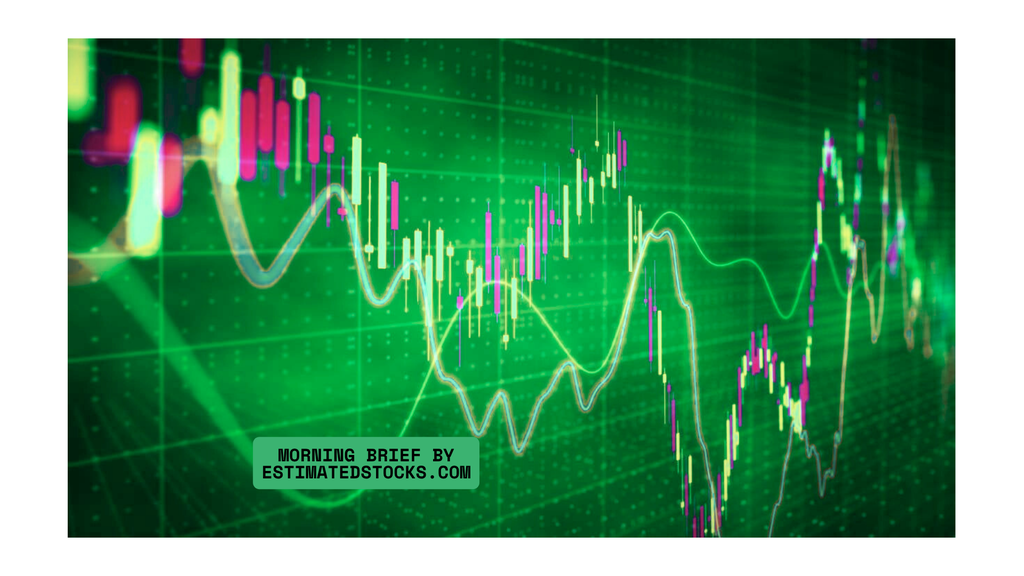
Weekly market insights on inflation, tariffs, global capital shifts, and investment strategy. Stay ahead with sector picks, risks, and smart portfolio moves.
Weekly Market Pulse: Clouds, Chaos & Capital Flows ☁️📉💸
1️⃣ Introduction:
The market this week is basically a financial version of Succession — power struggles, global shocks, and moody plot twists. Between sticky inflation, a confusing labor market, housing resilience, and a trade war sequel nobody asked for, investors are navigating one of the most unpredictable macro environments in years.
Add in rising Treasury yields, a dramatic shift in capital flows, and a tariff tantrum worthy of its own blockbuster — and you’ve got a market that’s buzzing, bracing, and borderline breaking.
2️⃣ Macro Trends Breakdown:
🌟 The Good:
- Jobs Hold the Line: April Non-Farm Payrolls jumped +177K (vs. 130K est), with private sector strength (+167K). Unemployment steady at 4.2%.
- Housing Surprises: New home sales surged +10.9%, while housing starts rose +1.6% MoM — a defiant stand in the face of 6.86% mortgage rates.
- Manufacturing Revival: U.S. and global PMIs (S&P Global Flash) both hit 52.3 — expansion mode, baby.
- Factory Orders Surge: March saw a massive +4.3% MoM jump in factory activity. Industrial demand isn’t dead yet.
- Global Equity Rotation: Big inflows into EU & emerging market ETFs — investors are hedging U.S. risk and seeking greener (foreign) pastures.
- Trump’s Infrastructure Spending: New tax credits and military investment plans are a boon for industrials, pipelines, and defense sectors.
💩 The Bad:
- Retail Sales Flatlining: April headline barely grew (+0.1%), and core control group sales fell -0.2%. Consumers are getting tired — and tight 💸.
- Mortgage Squeeze: Rates climbing again (30-yr fixed at 6.86%) — hitting affordability and slowing building permits (-4% MoM).
- Business Optimism Drops: NFIB Small Business Index slid to 95.8 — lowest in over a year.
- Bond Market Selloff: Treasuries are being dumped — 30-yr yield above 5.1%, a warning flare of declining faith in U.S. fiscal management.
- Corporate Margin Stress: Global retailers (e.g., Walmart, Target) are spooked by tariff risks and rising COGS.
🤯 The Ugly:
- Inflation Refuses to Die: Core CPI still sticky at 2.3% YoY — and inflation expectations have spiked to 7.3%. 👀
- Tariff Shockwave: U.S. aims to impose up to 50% tariffs on EU autos and electronics — Brussels preparing $108B in retaliation.
- Apple Gets Hammered: A 25% tariff threat wiped $100B off Apple’s value — proving that even mega-caps aren’t safe in trade war 2.0.
- Consumer Sentiment Collapses: U. of Michigan sentiment index dropped to 50.8 — lowest since the pandemic days.
- Debt Crisis Fears: Moody’s downgraded U.S. credit rating, citing exploding deficits (+$3T tax cut plan passed). Investors are now pricing in fiscal risk.
3️⃣ Investing Insights:
💪 Sectors Poised to Outperform:
- Domestic Industrials & Manufacturing: Beneficiaries of reshoring, tariffs, and Trump’s tax breaks. Think aerospace, construction, defense.
- Homebuilders & Construction: Surprisingly resilient — betting on demand even in high-rate terrain.
- Defense & Energy Infrastructure: Pipeline firms, defense contractors, and nuclear players could ride the policy wave.
- International ETFs: Europe and Emerging Markets (VEA, IEFA, VWO) are drawing capital as the “Sell America” trade gains steam.
- Tariff-Immune Tech: SaaS, cybersecurity, and U.S.-focused AI firms dodge global supply chain disruptions.
⚡ Sectors at Risk:
- Luxury & Auto (EU): LVMH, BMW, Mercedes staring down a 50% tariff barrel 🔫.
- Big Tech Hardware: Apple, Samsung, Dell, and others with Asia-based supply chains = exposed.
- Retail & Consumer Discretionary: Weak sales + tariffs + margin compression = red zone.
- Treasuries: Long-duration bonds are no longer a haven. Dumped by global investors.
4️⃣ Biggest Risks Ahead:
- 🧨 Sticky Inflation: Wage gains + labor costs = persistent core inflation and policy paralysis.
- 📉 Demand Destruction: Real wage growth is lagging — spending power erosion in full effect.
- 💣 Trade War Spiral: EU, Canada, and China lining up retaliatory tariffs — global supply chain shake-up incoming.
- 🧊 Liquidity Crunch: Fed QT continues, Fed balance sheet down to $6.69T — draining the punch bowl.
- 💵 Dollar Deterioration: If foreigners keep avoiding Treasuries, the USD’s shine may fade faster than expected.
5️⃣ Final Take: Investment Strategy Recommendations 💡
⚖️ Posture: Defensive Core, Tactical Aggression
✅ Favor:
- Dividend-paying large caps (utilities, health care)
- Short-duration Treasuries (4.2%+ yields = safety + income)
- High-quality international ETFs (VEA, IEFA, VWO)
- Domestic industrials, energy infrastructure, defense
🚫 Avoid / Reduce:
- Long-duration bonds
- Consumer discretionary & global retail
- Tech hardware tied to overseas manufacturing
- High-yield corporates (rising default risk)
💡 Portfolio Tip: Stick with a barbell strategy — anchor with safe yield + selectively tilt into high-conviction, macro-aligned sectors (think energy, defense, AI-industrials). Think bamboo, not brittle glass — flexibility wins in foggy terrain.
6️⃣ Conclusion:
This isn’t just a soft landing vs. hard landing debate anymore — it’s a full-blown financial identity crisis. Is the U.S. still the safest game in town? Or are investors waking up to a new multipolar capital landscape?
We’ve got inflation without relief, tariffs without strategy, and growth without confidence. And the only thing rising faster than bond yields? Investor anxiety 😅.
🔮 Final Thought: When bond markets, consumers, and CEOs are all screaming “danger ahead,” it’s time to stop guessing and start hedging. Flexibility, global diversification, and quality yield are your best co-pilots.
Disclaimer:
The information provided in this article is for educational purposes only and should not be construed as investment advice. estima...
Author
Shaik K is an expert in financial markets, a seasoned trader, and investor with over two decades of experience. As the CEO of a leading fintech company, he has a proven track record in financial products research and developing technology-driven solutions. His extensive knowledge of market dynamics and innovative strategies positions him at the forefront of the fintech industry, driving growth and innovation in financial services.


